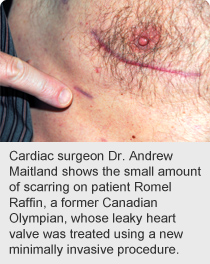
November 28, 2012
Story and Photo by Colin Zak
Romel Raffin isn’t the sort of fellow who likes to sit around.
The 58-year-old Olympian, who was on the Canadian men’s basketball team at the 1976, 1984 and 1988 Summer Games, continues to maintain an active lifestyle: exercising every day and playing hockey twice a week.
 Not even a leaky heart valve slowed him down for too long, thanks to a leading-edge cardiac procedure now being performed in the province for the first time. The procedure is used to treat mitral and aortic regurgitation, conditions in which blood leaks backwards through the heart valve, which can lead to irregular heart beats (arrhythmias) or heart failure if left untreated.
Not even a leaky heart valve slowed him down for too long, thanks to a leading-edge cardiac procedure now being performed in the province for the first time. The procedure is used to treat mitral and aortic regurgitation, conditions in which blood leaks backwards through the heart valve, which can lead to irregular heart beats (arrhythmias) or heart failure if left untreated.
“The day after the procedure, I was up walking around. Six weeks after the operation, I was back at the gym and going for walks every day,” says Raffin.
The minimally invasive procedure – performed at the Libin Cardiovascular Institute of Alberta, an entity of both Alberta Health Services (AHS) and the University of Calgary – reduces hospital stays, speeds recovery and leaves smaller scars.
Traditional valve repair involves making a 10-centimetre incision down the centre of the chest and cutting through the breastbone. Instead, the new procedure involves making a four- to five-centimetre incision to the side of the chest, without cutting any bone. Instruments are then inserted and the valve is repaired via telescope.
The entire operation takes several hours, with patients spending three or four days recovering in hospital – about half the time they would spend after traditional valve repair surgery. Patients can expect to make a full recovery within six weeks.
“The main benefit to patients is quality of life – it allows them to return to their normal lives and resume their normal level of physical activity sooner,” says Dr. Andrew Maitland, the cardiac surgeon who led the Foothills Medical Centre team performing the procedures. Maitland is also an Associate Professor in the Departments of Cardiac Sciences/Surgery in the Faculty of Medicine at the University of Calgary.
“This new procedure will likely lead to better outcomes for patients. Another plus of this procedure is that it leaves less visible scars, rather than having a big scar going down the front of the chest.”
Ten patients have already undergone minimal-incision aortic and mitral valve repair since the procedure was first performed on May 30
Dr. Imtiaz Ali, Section Chief of Cardiac Surgery for AHS, says that refining skills and introducing leading-edge procedures has become a hallmark of the work happening at the Libin Cardiovascular Institute of Alberta.
“Our cardiac surgeons have continued to lead the province – and the country – when it comes to pioneering new and innovative procedures,” Ali says. “Ultimately this will not only improve patient outcomes but recovery time and overall quality of life after their operation.”